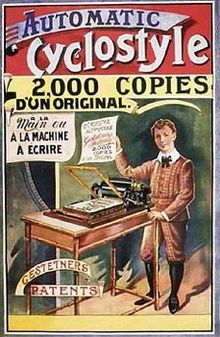
In computing, a printer is a peripheral machine which makes a durable representation of graphics or text, usually on paper. While most output is human-readable, bar code printers are an example of an expanded use for printers. Different types of printers include 3D printers, inkjet printers, laser printers, and thermal printers.

A mimeograph machine was a low-cost duplicating machine that worked by forcing ink through a stencil onto paper. The process was called mimeography, and a copy made by the process was a mimeograph.

A plotter is a machine that produces vector graphics drawings. Plotters draw lines on paper using a pen, or in some applications, use a knife to cut a material like vinyl or leather. In the latter case, they are sometimes known as a cutting plotter.

Printmaking is the process of creating artworks by printing, normally on paper, but also on fabric, wood, metal, and other surfaces. "Traditional printmaking" normally covers only the process of creating prints using a hand processed technique, rather than a photographic reproduction of a visual artwork which would be printed using an electronic machine ; however, there is some cross-over between traditional and digital printmaking, including risograph.

Laser printing is an electrostatic digital printing process. It produces high-quality text and graphics by repeatedly passing a laser beam back and forth over a negatively charged cylinder called a "drum" to define a differentially charged image. The drum then selectively collects electrically charged powdered ink (toner), and transfers the image to paper, which is then heated to permanently fuse the text, imagery, or both to the paper. As with digital photocopiers, laser printers employ a xerographic printing process. Laser printing differs from traditional xerography as implemented in analog photocopiers in that in the latter, the image is formed by reflecting light off an existing document onto the exposed drum.
Duplicating machines were the predecessors of modern document-reproduction technology. They have now been replaced by digital duplicators, scanners, laser printers, and photocopiers, but for many years they were the primary means of reproducing documents for limited-run distribution. The duplicator was pioneered by Thomas Edison and David Gestetner, with Gestetner dominating the market up until the late 1990s.
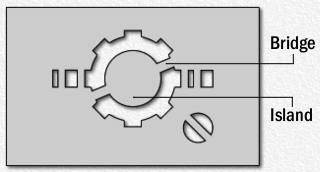
Stencilling produces an image or pattern on a surface by applying pigment to a surface through an intermediate object, with designed holes in the intermediate object. The holes allow the pigment to reach only some parts of the surface creating the design. The stencil is both the resulting image or pattern and the intermediate object; the context in which stencil is used makes clear which meaning is intended. In practice, the (object) stencil is usually a thin sheet of material, such as paper, plastic, wood or metal, with letters or a design cut from it, used to produce the letters or design on an underlying surface by applying pigment through the cut-out holes in the material.

The Gestetner is a type of duplicating machine named after its inventor, David Gestetner (1854–1939). During the 20th century, the term Gestetner was used as a verb—as in Gestetnering. The Gestetner company established its base in London, filing its first patent in 1879. The business grew, remaining within the control of the Gestetner family, and acquiring other businesses. In 1995, the Gestetner company was acquired by the Ricoh Corporation of Japan.
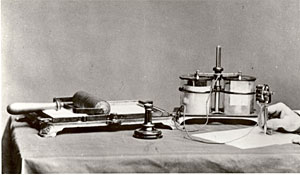
Thomas Edison's electric pen, part of a complete outfit for duplicating handwritten documents and drawings, was the first relatively safe electric-motor-driven office appliance produced and sold in the United States.
A writing implement or writing instrument is an object used to produce writing. Writing consists of different figures, lines, and or forms. Most of these items can be also used for other functions such as painting, drawing and technical drawing, but writing instruments generally have the ordinary requirement to create a smooth, controllable line.
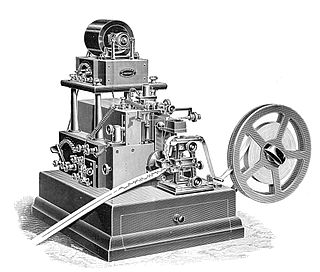
The syphon or siphon recorder is an obsolete electromechanical device used as a receiver for submarine telegraph cables invented by William Thomson, 1st Baron Kelvin in 1867. It automatically records an incoming telegraph message as a wiggling ink line on a roll of paper tape. Later a trained telegrapher would read the tape, translating the pulses representing the "dots" and "dashes" of the Morse code to characters of the text message.
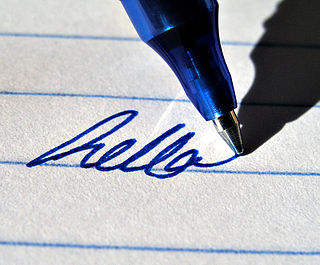
Roller ball pens or roll pens are pens which use ball-point writing mechanisms with water-based liquid or gelled ink, as opposed to the oil-based viscous inks found in ballpoint pens. These less viscous inks, which tend to saturate more deeply and more widely into paper than other types of ink, give roller ball pens their distinctive writing qualities. The writing point is a tiny ball, usually 0.5 or 0.7 mm in diameter, that transfers the ink from the reservoir onto the paper as the pen moves.

David Gestetner was the inventor of the Gestetner stencil duplicator, the first piece of office equipment that allowed production of numerous copies of documents quickly and inexpensively. He also invented a new kind of nail clipper. Gestetner was awarded the John Scott Medal by The Franklin Institute in 1888.
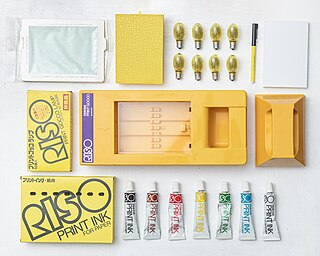
Print Gocco was a compact, self-contained card printing system developed by Riso Kagaku Corporation and first sold in 1977. Print Gocco achieved significant success and sold over 10 million units cumulatively before production ceased in 2008.

Risograph is a brand of digital duplicators manufactured by the Riso Kagaku Corporation, that are designed mainly for high-volume photocopying and printing. It was released in Japan in 1980. It is sometimes called a printer-duplicator, as newer models can be used as a network printer as well as a stand-alone duplicator. When printing or copying many duplicates of the same content, it is typically far less expensive per page than a conventional photocopier, laser printer, or inkjet printer.

Continuous stationery (UK) or continuous form paper (US) is paper which is designed for use with dot-matrix and line printers with appropriate paper-feed mechanisms. Other names include fan-fold paper, sprocket-feed paper, burst paper, lineflow, tractor-feed paper, and pin-feed paper. It can be single-ply or multi-ply, often described as multipart stationery or forms. Continuous stationery is often used when the final print medium is less critical in terms of the appearance at the edges, and when continuously connected individual sheets are not inconvenient for the application. Individual sheets can be separated at the perforation, and sheets also have edges with punched holes, which also can be removed at the perforation.

Royal Talens is a Dutch company located in Apeldoorn that specializes in art materials. The company produces and markets its own products, apart from commercializing other licensed brands, such as Van Gogh, Rembrandt, and Bruynzeel. Products commercialised include acrylic paints, oil paints, watercolor paintings, brushes, markers, inks, pastels, pencils, pens, gouache, canvas, papers.

The Wheatstone system was an automated telegraph system that replaced a human operator with machines capable of sending and recording Morse code at a consistent fast rate. The system included a perforator, which prepared punched paper tape called a Wheatstone slip, a transmitter that read the tape and converted the symbols into dots and dashes encoded as mark and space electric currents on the telegraph line, and a receiver at the other end of the telegraph line that printed the Morse symbols. The system was invented by Charles Wheatstone. Enhancements could be made so that it was a duplex system, able to send and receive on the same line simultaneously.

